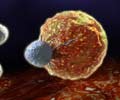New research delves into how gut bacteria influence T cells, offering insights into immune health and potential therapeutic strategies.

Blockbuster T cells in the gut: A high-resolution view of immune modulation by the gut microbiome is presented
Go to source).
Exploring the Impact of Gut Bacteria on Immune Health
Kazuki Nagashima, a senior research scientist at Stanford University, has been awarded this year’s NOSTER & Science Microbiome Prize for pioneering research that elucidates how gut bacteria affect T cells. His innovative approach identifies specific bacterium-T cell interactions, crucial for managing diseases influenced by‘Understanding "blockbuster" T cells could revolutionize gut health treatments. #immunehealth #medindia’





Nagashima’s research debunked prior assumptions by revealing that certain T cells, termed “blockbuster” T cells, can engage with multiple bacterial strains within the gut. This discovery opens new avenues for therapeutic interventions aimed at modulating immune responses beneficially.“This finding offers a promising therapeutic approach to manipulate gut immune reactions,” Nagashima emphasized upon receiving the prestigious award. His work underscores the potential to harness gut microbiota dynamics for treating a spectrum of diseases, marking a pivotal step forward in microbiome research.
The NOSTER & Science Microbiome Prize recognizes young investigators advancing the field of microbiota research, highlighting innovations with profound implications for therapeutic development.
Reference:
- Blockbuster T cells in the gut: A high-resolution view of immune modulation by the gut microbiome is presented - (https://www.science.org/doi/10.1126/science.adq2335)
Source-Eurekalert











